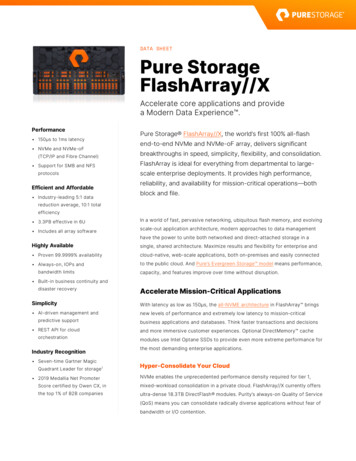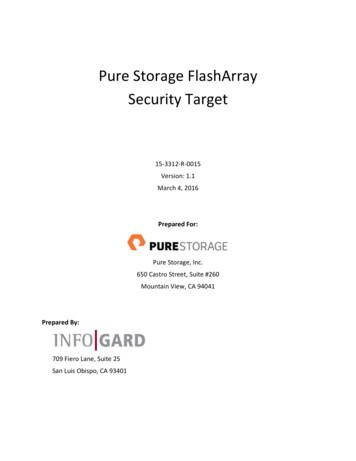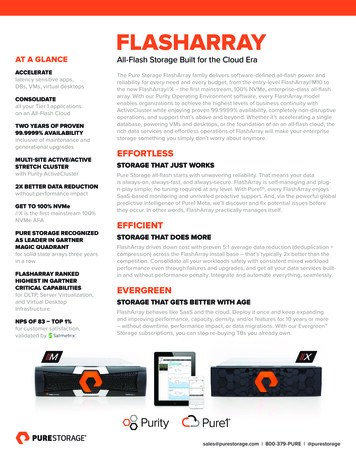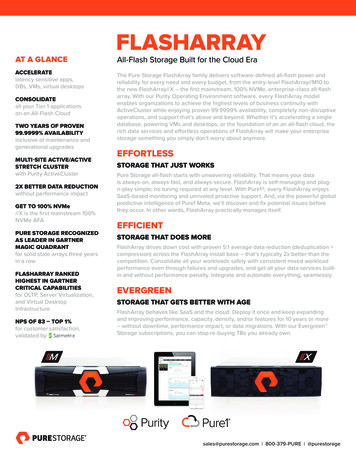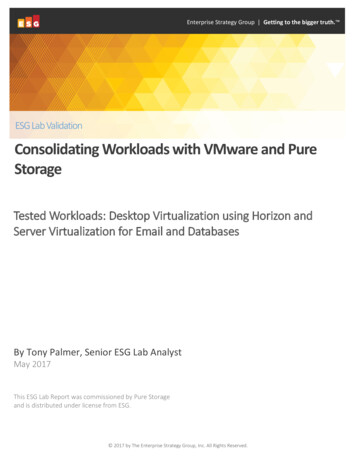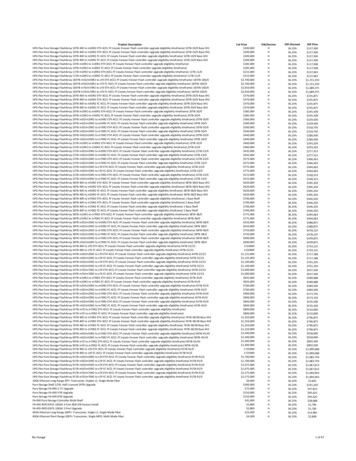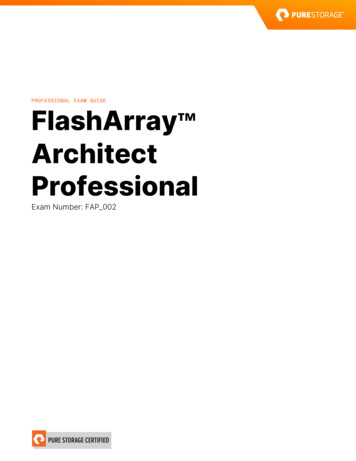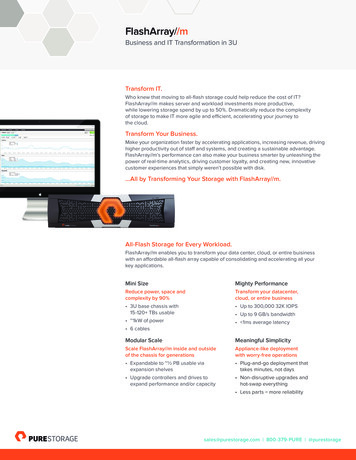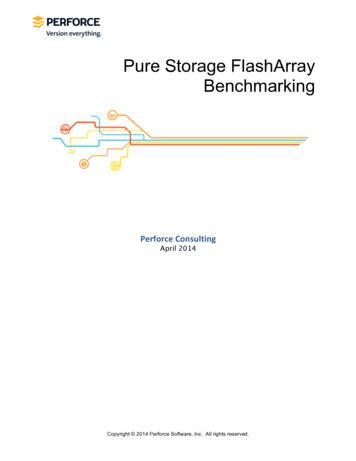
Transcription
Pure Storage FlashArrayBenchmarkingPerforceConsultingApril 2014Copyright 2014 Perforce Software, Inc. All rights reserved.
OVERVIEWThis report shows two of the standard benchmarks from Perforce to quantify the performancecharacteristics of the Pure Storage FlashArray.To perform this benchmark, Perforce utilized a FA-420 from Pure Storage. The results of thebenchmarks are presented within this report.The Pure Storage FlashArray is configured with multipath and NOOP scheduler. A single 8 Gigdual port fiber card was used to attach the Pure Storage to the server. No FC switches wereutilized.REFERENCESThe following documents were referenced for specific configuration guidelines andrecommendations: AREThe benchmarks focus on “read” and “write” performance of the Pure Storage FlashArray as itapplies to Perforce applications.BinaryPerforce SoftwareP4Rev. P4/LINUX26X86 64/2014.1/807760 (2014/03/18)P4DRev. P4D/LINUX26X86 64/2014.1/807760 (2014/03/18)The following tables list the hardware configuration of the Pure Storage devices used in thisanalysis:DescriptionPure Storage FA-420 Series Memory ArrayModelPure Storage FlashArray FA-420 with Purity version 3.4.2Storage Shelves2 shelves, each with 22 cMLC 238GB drives and 2 2GB NVRAM drivesControllers2 FA-420 controllers interconnected via 2x 56 Gb/s InfiniBandFCP4/8Gb/s Fibre Channel x8
The following tables list the server hardware configuration used in this analysis:DescriptionP4D Server Hardware SpecificationsMachine Namepln4ModelHP Proliant DL580 G7Memory512 GBProcessors(4) Intel(R) Xeon(R) CPU X7542 @ 2.67GHz (24 cores)Diskspace(8) 146.8 GB 15k SCSIInterfaces(2) 10/1000FCP HBA4/8Gb/s Fibre Channel (configured 8Gb/s) x8OSSUSE Linux Enterprise Server 11 (x86 64) - Service Pack 1Kernel2.6.32.12-0.7-defaultDescriptionBrowse Client Server Hardware SpecificationsMachine Nameplsbep2fModelHP Proliant DL380p G8Memory384 GBProcessors(2) Intel(R) Xeon(R) CPU E5-2690 0 @ 2.90GHz (16 cores total)Diskspace(16) 300 GB 15k SASInterfaces(2) 10/1000OSSUSE Linux Enterprise Server 11 (x86 64) Patch Level 3Kernel3.0.101-0.8-default
DescriptionBrowse Client Server Hardware SpecificationsMachine Nameplsbep2gModelHP Proliant DL380p G8Memory384 GBProcessors(2) Intel(R) Xeon(R) CPU E5-2690 0 @ 2.90GHz (16 cores total)Diskspace(16) 300 GB 15k SASInterfaces(2) 10/1000OSSUSE Linux Enterprise Server 11 (x86 64) Patch Level 3Kernel3.0.101-0.8-defaultCONFIGURATIONFollowing the best practices, we incorporated the NOOP I/O scheduler, 4k LUN alignment andmultipathing.The IO scheduler was set globally as a menu.lst boot parameter.The 4k LUN alignment was exercised by using a 4k sector size when creating the XFS filesystem. This was confirmed by using the vpartial utility.
MULTIPATHThe following multipath.conf was used for the multipath tests. The example templates can befound in /usr/share/doc/packages/multipath-tools. The device configuration settings included inthis multipath.conf are recommended in Pure Storage's User Reference Guide. Multipathingwas configured in active/active mode.blacklist exceptions {device {vendor}}"PURE"## Use user friendly names, instead of using WWIDs as names.defaults {user friendly namesyesmax fdsmaxflush on last delyesqueue without daemon no}blacklist {wwid 3600508b1001c52e2d818a1196da1e48fdevnode " hd[a-z]"devnode " (ram raw loop fd md dm- sr scd st)[0-9]*"#devnode " (ram raw loop fd md sr scd st)[0-9]*"}blacklist {device {vendor}}"HP"devices {device {vendorpath selectorpath grouping policyrr min iopath checker}}"PURE""round-robin 0"multibus1tur
BENCHMARKS BRANCHSUBMITThe Perforce Server (P4D) synchronizes access to its metadata through the use of filelocks on the db.* tables. For Perforce tasks that only need to read portions of themetadata, P4D takes read locks on only those db.* tables containing metadata neededby the task. If a task needs to update metadata within a db.* table, P4D takes a writelock on the db.* table. A read lock on a db.* table can be shared with other read lockson the same db.* table, but a write lock on a db.* table is exclusive of all other locks onthat db.* table. In general, P4D minimizes the duration that a write lock is held on a db.*table.One notable exception that can result in P4D holding a write lock on a db.* table for anextended duration is the commit portion of a large changelist submission's dmCommitSubmit phase. Since the commit portion must be atomic, P4D holds write lockson several important db.* tables for the duration of the commit portion of a changelistsubmission's dm-CommitSubmit phase. The write locks held block all other tasks thatneed access to the same tables. It is important that the commit portion of a changelistsubmission's dm-CommitSubmit phase execute as quickly as possible so that the writelocks are released, making the db.* tables available for access to the waiting tasks. BRANCHSUBMIT SUMMARYThe branchsubmit benchmark results are listed in the following table. The benchmarkscenario was run twice, once with 70k files, and once with 700k files per request. The FiberChannel Protocol (FCP) was used on the Pure Storage FA-420.While all branchsubmit benchmark statistics are meaningful, the Commit Rate andElapsed Time results are the most revealing. The Commit Rate (higher results are better)is calculated by the number of files submitted divided by the amount of time a write lock isheld on the db.integed table. Elapsed Time (lower results are better) is the total amount oftime the submit operation takes to complete. Specifically, it is the amount of time the forkedchild process exists during the submit operation.StoragePure StorageFCPRunCommit Elapsed Compute Exiting CommitRateTimePhaseTime Duration1 - 70k files15024 f/s8 sec.5605 ms.1 sec.4659 ms2 - 70k files21387 f/s7 sec.5429 ms.2 sec.3273 ms1 - 700k files12130 f/s80 sec.52423 ms.3 sec.57704 ms2 - 700k files20037 f/s62 sec.50678 ms.8 sec.34934 ms
BROWSE.The Browse Benchmark involves a single P4D server and multiple browsechild clientmachines. Each browsechild instance launched places a load on the server byexecuting commands that simulate the operational characteristics of the PerforceP4V client. Depending upon the configuration, this test can be CPU and networkintensive. Varying the settings for the benchmark configuration can provideinformation that gauge how well a computer handles a particular load. The browsebenchmark focuses on “read” performance. BROWSE SUMMARYThe results of this benchmark are presented below. These results are meaningful whenused to compare against another device’s performance in this test.The configuration used is: FA-420 Pure Storage FlashArray FCP (Fibre Channel Protocol) MultipathingDevice/Scheduler/Protocol 64 children * 2 128 children * 2FA-420/noop/FCP 298 seconds668 secondsPURE STORAGE DATA REDUCTIONUsing Pure Storage CloudAssist, Pure Storage captured a view of the FlashArray afterthe end of the benchmark testing. The capture revealed a data reduction ratio of 5.2:1.
characteristics of the Pure Storage FlashArray. To perform this benchmark, Perforce utilized a FA-420 from Pure Storage. The results of the benchmarks are presented within this report. The Pure Storage FlashArray is configured with multipath and NOOP scheduler. A single 8 Gig dual port fiber card was used to attach the Pure Storage to the server.

